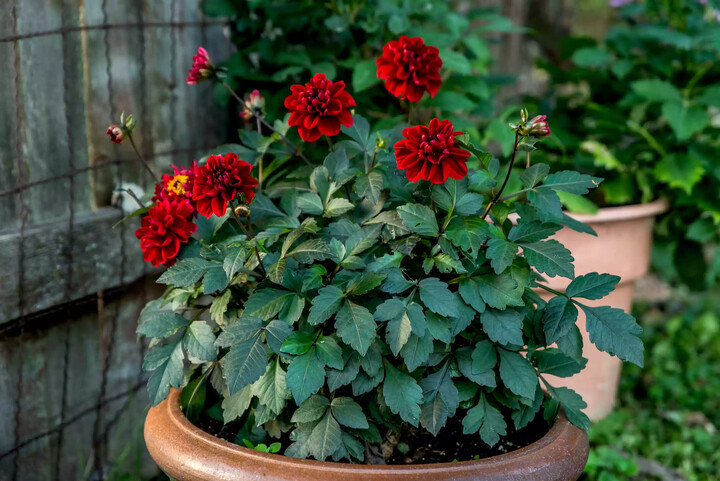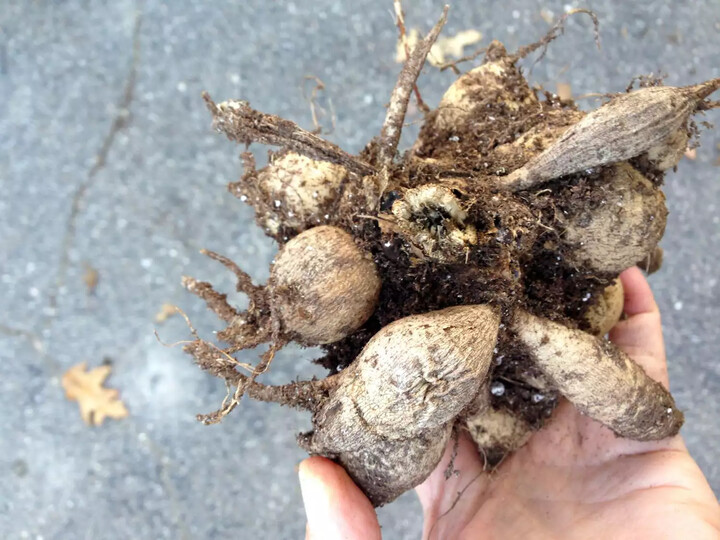There is an amazing number of dahlia varieties—almost all of them drop-dead gorgeous.They range in size from small to the gigantic and aptly named "dinner plate" varieties. Dahlia blooms go from simple to almost psychedelic in color and form, from tiny pompon with tightly geometric flowers to cactus varieties with flower petals with long, spidery tentacles. Dahlias make luxurious cut flowers and as perennials, they are normally planted in the ground. But depending on the size of the variety, they can also play the role of a thriller or filler plant in a mixed container. Most dahlias bloom from mid-summer through fall in most areas, so you must expect your container plants to be without color until bloom time. The foliage, however, can provide a nice architectural structure in a mixed planting in a large pot.
Growing Dahlias in Pots
Dahlias grow well in pots, though you need to be very careful not to let them repeatedly dry out.1 They also will need to be regularly fertilized during the growing season, and many will need to be staked so they don't fall over. It's also a good idea to put the taller varieties in heavy pots, so a stiff wind doesn't blow them over.
You can buy dahlia tubers online or in nurseries and some big box stores. Many nurseries also sell dahlias already started in containers. Dahlias come in a huge range of flower size as well as plant size. If you are looking for enormous flowers, look for "dinner plate" dahlias. If you are looking for shorter plants look for miniatures, or "low growing" dahlias.

Planting in Pots
If you live in a colder climate and want your dahlias to bloom earlier, you can plant them indoors about 6 weeks before the last frost. However, if you do plant them inside, it's a good idea to provide supplemental lighting once the plant breaks through to the surface of your soil. For lighting, you can either use shop lights fitted with one cool and one warm fluorescent bulb or special "grow lights."
If you are starting your dahlias in pots outside, wait until all danger of frost has passed or make sure you can move your pot inside if frost is predicted.
For most dahlias, you want a fairly large pot, though it doesn't need to be very deep. Many varieties would do well in a 12- to 14-inch diameter pot which is also at least 12 inches deep. Also, make sure the pot has good drainage because the tubers will rot if left to sit in water.
Choose a good all-purpose, fast-draining potting mix and stir in a slow-release fertilizer, following the label for directions on quantity. Dahlia tubers can be a bit unwieldy and large so, unless you are going to separate them, you will need to be careful when planting in containers. Make sure that the potting mix surrounds all the parts of the tuber without leaving any air pockets, and that the top of the plant is pointing upward (look for eyes, like you would find on a potato or where they stem used to come out of the bunch). Mound a few inches of potting soil on the bottom of the pot, forming a little bit of a hill and balance the tuber on the mound. Then carefully fill in around the tuber with potting soil, firming it around the tuber gently to avoid breaking them. Some people recommend layering the soil and slowly filling up the pot as the plant grows.
Care and Maintenance
Dahlias like full sun, though don't like to get searingly hot. If you live in a warm climate or your pot is in a hot spot (in a corner or on concrete where the surface gets hot) move your pot into a shady spot during the heat of the day. 1
Keep the soil moist, but not wet. Most dahlias will have to be staked so they don't fall over. Also, depending on the depth of your pot, a single stake might not do the trick of holding up the plant either—particularly in a stiff breeze. You can make a teepee out of bamboo, or, for a fuller plant, pinch back the plant's growth to keep it bushier. Also, for more flowers, deadhead regularly.
Overwintering Dahlias
If you live in a cold climate it's best to overwinter dahlias. Wait until after a couple of frosts. Then, cut off the dead foliage a few inches about the soil and let the pot dry out in your garage or shed. At this point, carefully dig up the tubers and brush off all the extra dirt. Put them in a cardboard box and store them in dry, cool conditions, such as an open basement with good air circulation. In the spring, carefully inspect the tubers and replant only those that are firm and not desiccated or soft.

Buying Dahlias Already in Pots
Good nurseries often sell dahlias already potted up. This can be an advantage, particularly for the dinner plate variety, because they will (hopefully) have been properly pruned to get the best and biggest blossoms.
